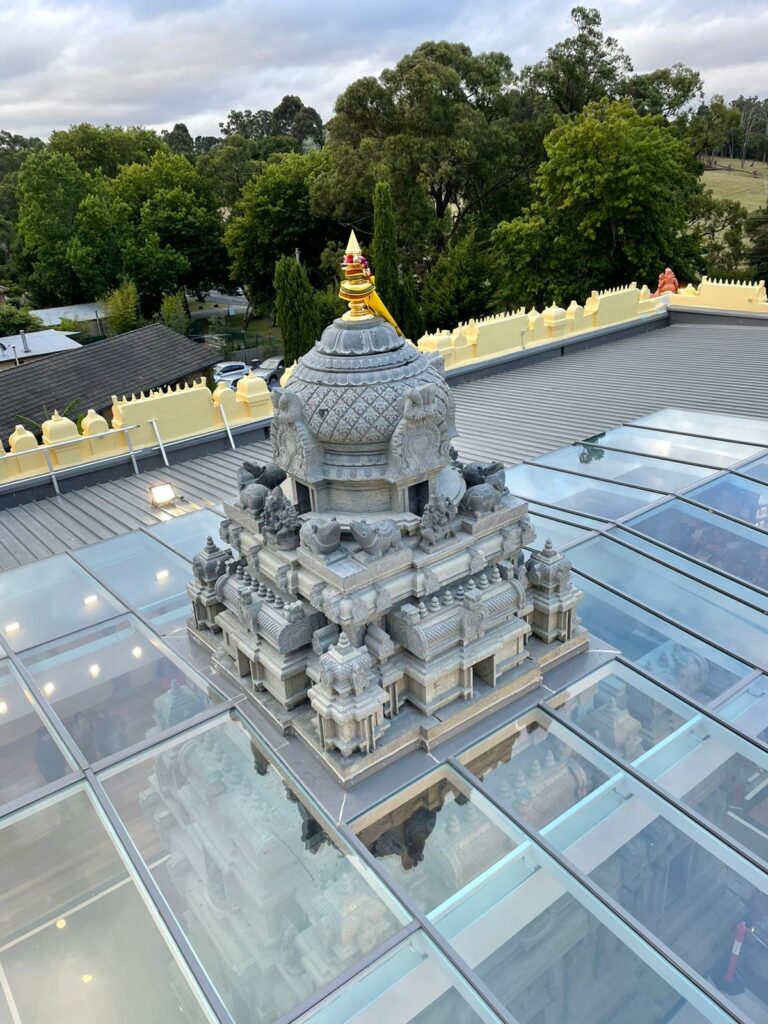A look into the meaning of Kumbhabhishekam

Written by Nisheathana Kokulan
‘Kumbhabhishekam’ is a consecration ceremony, which is performed either in a newly built or a renovated temple by establishing deities and performing rituals, which infuse the statues of the gods with divinity.
Kumbhabhisheka rituals should be carried out at least once in twelve years according to the agamas. It is very important to follow this ritual strictly to rejuvenate the Shakti (power) of the deity and to get the temple filled with vibrant positive energy.
The Kumbha (pot) is filled with water, conceptualizing it as the holy water from six sacred rivers. Divinity is transferred to the holy water by chanting mantras amidst rituals prescribed in the scriptures. The divinity is then transferred by performing abhishekam (ritualistic shower) on the statues inside the temple and kalasams, which are on the top of temple towers. This Abhishekam from the Kumbham is called Kumbhabishekam. This is a big blessing in one’s life since kumbhabhishekam happens once in several years. Participating in the yagna (fire rituals) worshipping and hearing mantras improves health and is good for our soul.
There are four kinds of kumbhabhishekams. They are, ‘Aavardhanam’, ‘Punaraavardhanam’, Anaavardhanam’, and ‘Andhareedham’ according to Sivagamas.
Aavardhanam – Building new temple from the very beginning, starting with identifying the right land and then constructing and making statues etc.
Punaraavardhanam – Restoring sanctity after all the renovation/repair works to the temple. For this the deities have to be moved to a temporary dwelling called Baalaalayam. When renovation is completed the deities are brought back and Kumbhabhishekam takes place.
Anaavardhanam – Rebuilding the temple, where worship has ceased due to natural or unnatural causes and bringing sanctity back.
Andhareedham – Done to restore the holiness if anything untoward happened in the temple.
In the above four, Andhareedham can happen at any time. The other three follow auspicious timings. This time is fixed after considering the favourability of thidhi, week, star, yogam and kaaranam.
The ultimate reality which is present throughout the universe is deified in the water and fire after ‘Aavaahanam’ which is later transferred to statues. That is the main purpose of ‘Kumbhabhishekam’.
Many rituals and procedures happen in the lead upto Kumbhabhishekam. A complete Kumbhabhishekam consists of 64 kinds of Kriyas (rituals). Some kriyas are explained below.
Mukurtha Nirnayam – Selecting the Auspicious Day and Time for Kumbhabhishekam.
Anukgnai – Obtaining permission and blessings from Gods namely Lord Shiva, Goddess Parvathy, Vinayagar, Subramaniyar, Sandeswarar and others.
Different Homas such as Ganapathy homa, Navagraha homa, Krama Shanthi etc. are performed to remove obstacles and safeguard the proceedings and devotees.
Kalaakarshanam – Transferring the divinity from the bimbum (deity) to kumbham.
Mruthsangirahanam and Ankuraarpanam – Ankuraarpanam is done by keeping Mulaipaligai (pot in which nine kinds of seeds are sown) before any festival for prosperity. Obtaining the soil with holiness for this Mulaipaligai is Mruthsangirahanam.
Rakshaabandhanam – This safety bracelet is worn to fulfill the oath taken to complete the kumbhabhishekam safely without interruptions.
Kumbalangaaram – Decorating the Kumbhams and Kalasams considering them as God’s body.
Bimbasthaabanam – Fixing the statues with peedams (base) using ashtabandhanam and doing pooja with nine gems, Panchalokam and Yanthram.
Ashtabandhanam – A paste made of rosin, komparakku, sukkaan powder, beeswax, kalkaavi powder, redcotton, buffalo butter and jaadhilingam which is believed to be the eight ‘Ashta Murthy’. Ashtabandhanam is used to join the base pedestal with the statues. So once Murthy is installed, the deity never moves.
Yaagasala – Structure of Yagnasala is determined inside the temple according to North East (Eesanam), South East (Agni Mulai), North and West directions.
Nadeesanthaanam – A connection is made by the priest to the Agni and to the Kumbham using Tharpai (can be string of plant, silver or gold) which is then used to transfer all the power of the homa.
Sparsaahuthi – Transfering the thirty six thathuvas from the yagna to the vigrahas in preparation for the Kumbhabhishekam.
After all the elaborate rituals with veda chanting are completed, on the auspicious day, at the auspicious time, all the kumbhas with holy water charged with all the veda mantras will be used to perform abhishekam for the kalasams on the temple towers and to the deities inside. This is Kumbhabhishekam by which the statues are infused with divinity.
Dasa Dharshanam – Ten auspicious items such as the mirror, cow, Brahmin etc. are displayed for Swami’s view before he views anything else.
After all these procedures ‘Mandalabhishekam’ will be done for forty five days and ‘Sangabhishekam’ is done on last day to conclude the Kumbhabhishekam.




